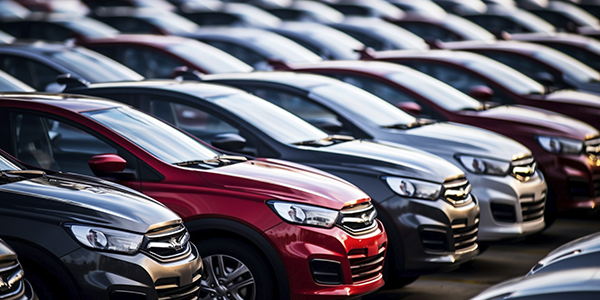By Joe Praveen Vijaykumar, Research Manager & Thanigesh Arumugam Parthasarathi, Research Analyst – Mobility
The fractious trade war between the US and China has entered a new phase with President Biden effectively quadrupling tariffs from 25% to 100% on Chinese made electric vehicles (EVs). In addition, levies on lithium-ion EV batteries have jumped from 7.5% to 25% and have doubled from 25% to 50% on semiconductors. The US government has declared these punitive measures a necessary response to protect the US auto industry from a flood of cheap Chinese imports, manage unfair trade practices, and rectify trade imbalances. The unspoken subtext? The decision comes in a crucial election year and the optics – saving US jobs and companies and making critical US sectors more competitive – are powerful.
The new tariff regime goes into effect three months from now.
From Open Economy to Protectionism
The current levies are the latest in a series of bruising tit for tat measures that began in 2018 between the world’s two largest economies. The steep hikes cover not just EVs and semiconductors but critical minerals, steel, aluminum, and solar panels, as well. This is part of a broader thrust by the US to create a strong, domestic industry driven green economy. Accordingly, restrictions will affect almost $18 billion of Chinese exports to the US.
For the auto industry, more specifically, the tariffs mirror a long-standing concern that without protectionism, a flood of affordable Chinese EVs will wreck the domestic automotive industry with unsustainable price competition. Automakers like Ford and GM have put a brake on EV production as they attempt to staunch mounting revenue losses. Concerns have also been raised about Chinese EVs siphoning away massive investments from EV and battery manufacturing in the US. Indeed, news reports quoted the Alliance for American Manufacturing as equating the free entry of cheap, highly subsidized Chinese cars into the US market to an “extinction-level event,” while ex-President Trump warned that it could result in a “bloodbath” of the US auto industry.
Our Perspective
While the latest announcement might sound dramatic, it is unlikely to result in any significant change on the ground. Under the Presidency of Donald Trump, the US had already imposed severe curbs on Chinese EVs making it extremely challenging for them to compete effectively. Consequently, there are only a handful of Chinese made cars, both EVs or ICE, available in the US today.
Volvo (in which Geely has a controlling stake) sells the plug-in hybrid S90 Recharge, EVs like Polestar 1 and Polestar 2, with plans on the anvil for Polestar 3 set to be produced in South Carolina and a small sport utility vehicle, the EX30, to be imported from China. ICE models like the Buick Envision (General Motors & SAIC) and Lincoln Nautilus (Ford & Changan) will not be impacted.
China’s heavyweight automakers – the state owned SAIC, FAW Group, Changan and Dongfeng, along with others like BYD – could seek to sidestep restrictions by setting up manufacturing facilities in Mexico, and then exporting these cars to the US under the North American Free Trade Agreement. Chinese EVs are already significantly less expensive than their US manufactured counterparts, with some estimates pegging them as being almost $10,000+ cheaper. Should Chinese automakers assemble their cars in Mexico, this price differential would be starker since it would potentially allow them to claim the $7,500 in federal tax credit for EVs. This would compel the US to undertake further preventative action.
Meanwhile, the Trump effect cannot be underestimated. Trump has already criticized the current administration for championing EVs at the cost of the ICE oriented US auto industry. He has also declared that, if elected President in November, he will levy 100% tariff on “every single car that comes across the line” from Chinese-owned manufacturing facilities, whether in China or Mexico. Furthermore, he has pledged to hike taxes on all Chinese imports by 60%. While this might align with his Make America Great Again slogan, it is likely to aggravate inflationary pressures on already beleaguered US consumers. Moreover, this could discourage consumers, who have shown limited appetite for EVs, from purchasing higher priced US produced models.
What will be interesting to see is how Europe responds. The reality here is much more complex because Chinese cars comprise around 3% of total vehicle sales in Europe, while it is nearly 9% in the case of the region’s EV market.
It is unlikely that Europe will take any immediate action since it would mean a substantial slowing down of the transition to vehicle electrification. Moreover, it would affect European automakers such as Volvo whose EX30 is its best-selling model in Europe. It would also impact OEMs such as Volkswagen that manufacture their vehicles in China to be sold into mainland Europe. As it is, protectionism is poised to upset supply chains and push up cost inflation, resulting in higher priced EVs and potentially, therefore, lower consumer demand.
For China, although the US is a small market, ripple effects and retaliatory measures in other regions could be disastrous. Assisted by government subsidies, the Chinese auto industry suffers from overcapacity, especially in terms of EV production. With its domestic market saturated, Chinese automakers are, therefore, heavily dependent on exports to other Asian countries, Europe, and Latin America. If these avenues are closed out, China’s EV juggernaut could well splutter.
The events over the course of this year will reveal how, whether, and if, the US tariffs will derail the ambitions of Chinese automakers.
With inputs from Amrita Shetty, Senior Manager, Communications & Content – Mobility






